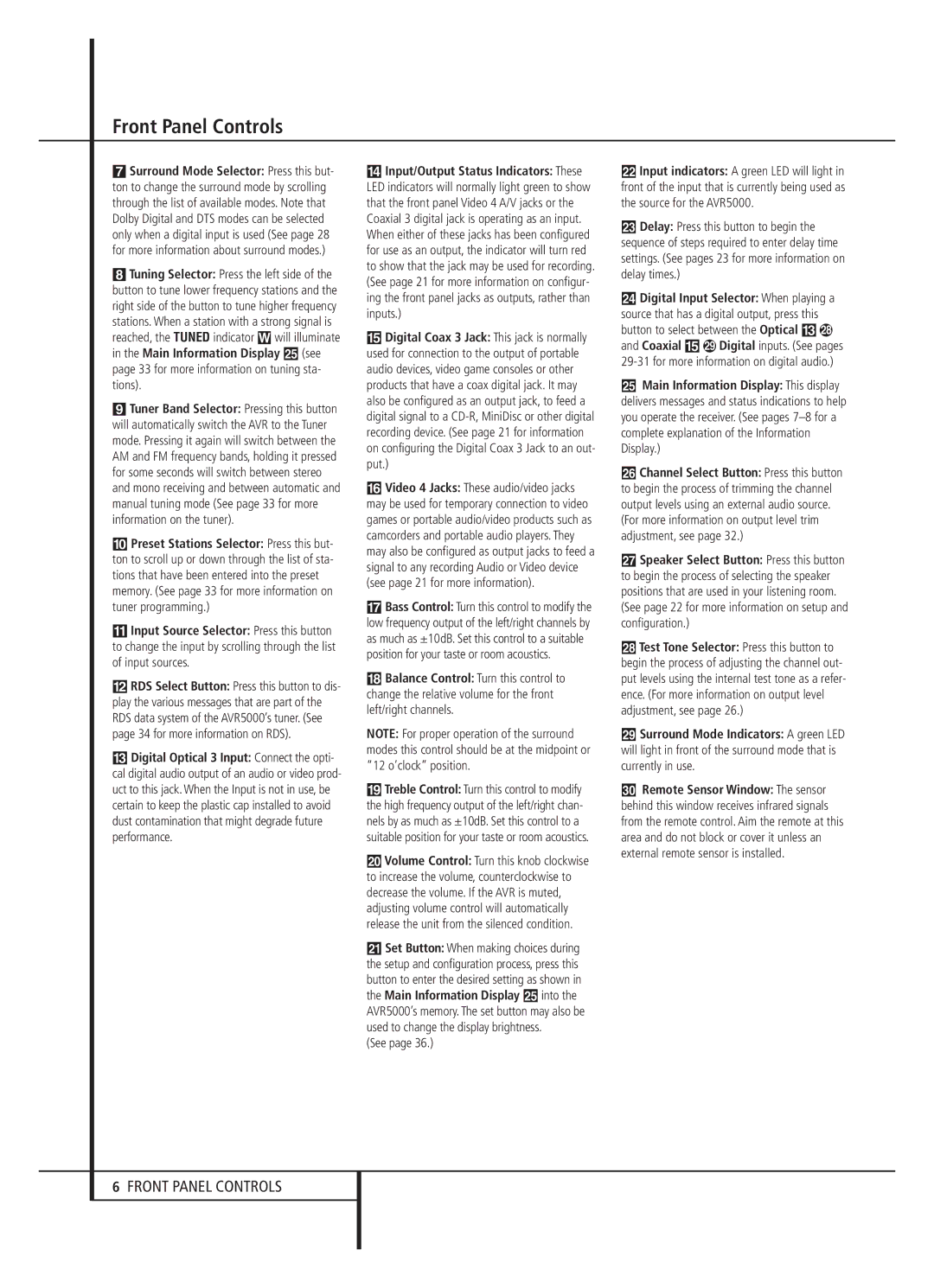
Front Panel Controls
7Surround Mode Selector: Press this but- ton to change the surround mode by scrolling through the list of available modes. Note that Dolby Digital and DTS modes can be selected only when a digital input is used (See page 28 for more information about surround modes.)
8Tuning Selector: Press the left side of the button to tune lower frequency stations and the right side of the button to tune higher frequency stations. When a station with a strong signal is reached, the TUNED indicator Wwill illuminate in the Main Information Display Û (see page 33 for more information on tuning sta- tions).
9Tuner Band Selector: Pressing this button will automatically switch the AVR to the Tuner mode. Pressing it again will switch between the AM and FM frequency bands, holding it pressed for some seconds will switch between stereo and mono receiving and between automatic and manual tuning mode (See page 33 for more information on the tuner).
)Preset Stations Selector: Press this but- ton to scroll up or down through the list of sta- tions that have been entered into the preset memory. (See page 33 for more information on tuner programming.)
!Input Source Selector: Press this button to change the input by scrolling through the list of input sources.
@RDS Select Button: Press this button to dis- play the various messages that are part of the RDS data system of the AVR5000’s tuner. (See page 34 for more information on RDS).
#Digital Optical 3 Input: Connect the opti- cal digital audio output of an audio or video prod- uct to this jack. When the Input is not in use, be certain to keep the plastic cap installed to avoid dust contamination that might degrade future performance.
$Input/Output Status Indicators: These LED indicators will normally light green to show that the front panel Video 4 A/V jacks or the Coaxial 3 digital jack is operating as an input. When either of these jacks has been configured for use as an output, the indicator will turn red to show that the jack may be used for recording. (See page 21 for more information on configur- ing the front panel jacks as outputs, rather than inputs.)
%Digital Coax 3 Jack: This jack is normally used for connection to the output of portable audio devices, video game consoles or other products that have a coax digital jack. It may also be configured as an output jack, to feed a digital signal to a
^Video 4 Jacks: These audio/video jacks may be used for temporary connection to video games or portable audio/video products such as camcorders and portable audio players. They may also be configured as output jacks to feed a signal to any recording Audio or Video device (see page 21 for more information).
&Bass Control: Turn this control to modify the low frequency output of the left/right channels by as much as ±10dB. Set this control to a suitable position for your taste or room acoustics.
*Balance Control: Turn this control to change the relative volume for the front left/right channels.
NOTE: For proper operation of the surround modes this control should be at the midpoint or “12 o’clock” position.
(Treble Control: Turn this control to modify the high frequency output of the left/right chan- nels by as much as ±10dB. Set this control to a suitable position for your taste or room acoustics.
ÓVolume Control: Turn this knob clockwise to increase the volume, counterclockwise to decrease the volume. If the AVR is muted, adjusting volume control will automatically release the unit from the silenced condition.
ÔSet Button: When making choices during the setup and configuration process, press this button to enter the desired setting as shown in the Main Information Display Ûinto the AVR5000’s memory. The set button may also be used to change the display brightness.
(See page 36.)
Input indicators: A green LED will light in front of the input that is currently being used as the source for the AVR5000.
ÒDelay: Press this button to begin the sequence of steps required to enter delay time settings. (See pages 23 for more information on delay times.)
ÚDigital Input Selector: When playing a source that has a digital output, press this button to select between the Optical # and Coaxial % Digital inputs. (See pages
ÛMain Information Display: This display delivers messages and status indications to help you operate the receiver. (See pages
ÙChannel Select Button: Press this button to begin the process of trimming the channel output levels using an external audio source. (For more information on output level trim adjustment, see page 32.)
ıSpeaker Select Button: Press this button to begin the process of selecting the speaker positions that are used in your listening room. (See page 22 for more information on setup and configuration.)
ˆTest Tone Selector: Press this button to begin the process of adjusting the channel out- put levels using the internal test tone as a refer- ence. (For more information on output level adjustment, see page 26.)
˜Surround Mode Indicators: A green LED will light in front of the surround mode that is currently in use.
¯Remote Sensor Window: The sensor behind this window receives infrared signals from the remote control. Aim the remote at this area and do not block or cover it unless an external remote sensor is installed.
6FRONT PANEL CONTROLS
